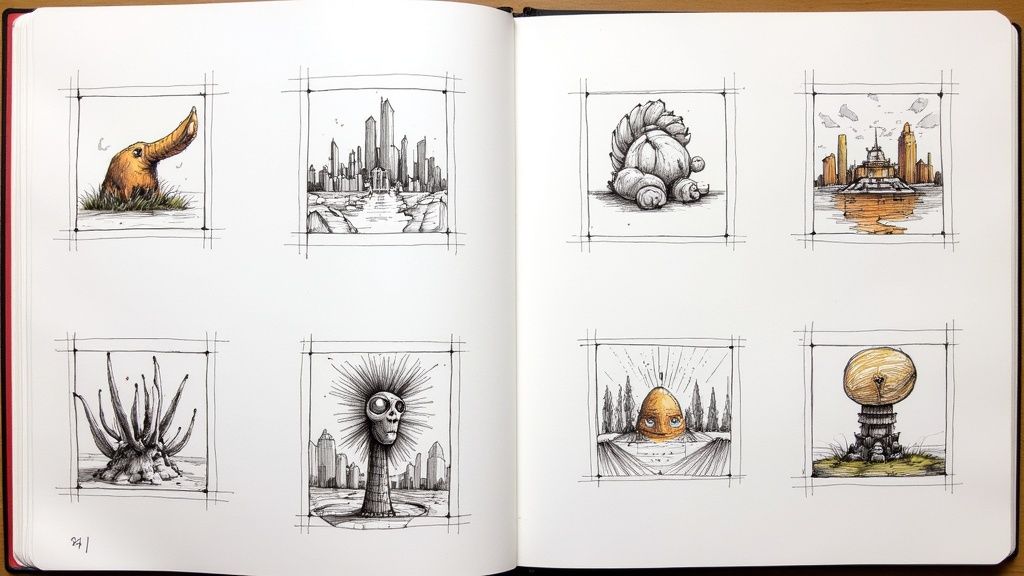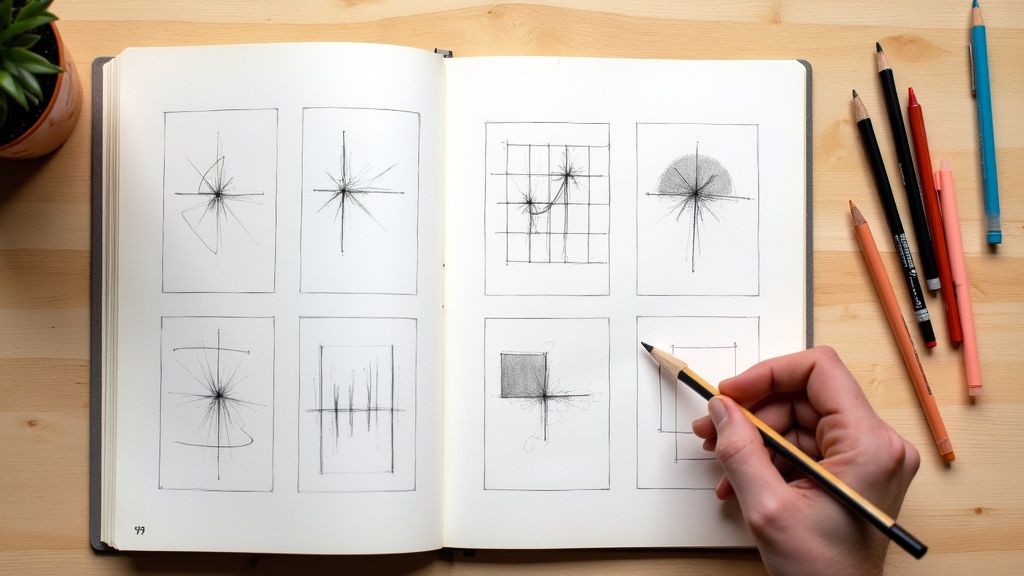Let's get one thing straight—the idea that you're either born a great artist or you're not is a complete myth. If you feel like your drawing skills have hit a wall, it’s not because you lack talent. It's almost always because you're not practicing the right things.
Real, noticeable improvement comes from deliberate, focused practice on the fundamentals. It’s about quality, not just quantity.
Your Journey to Better Drawing Starts Now
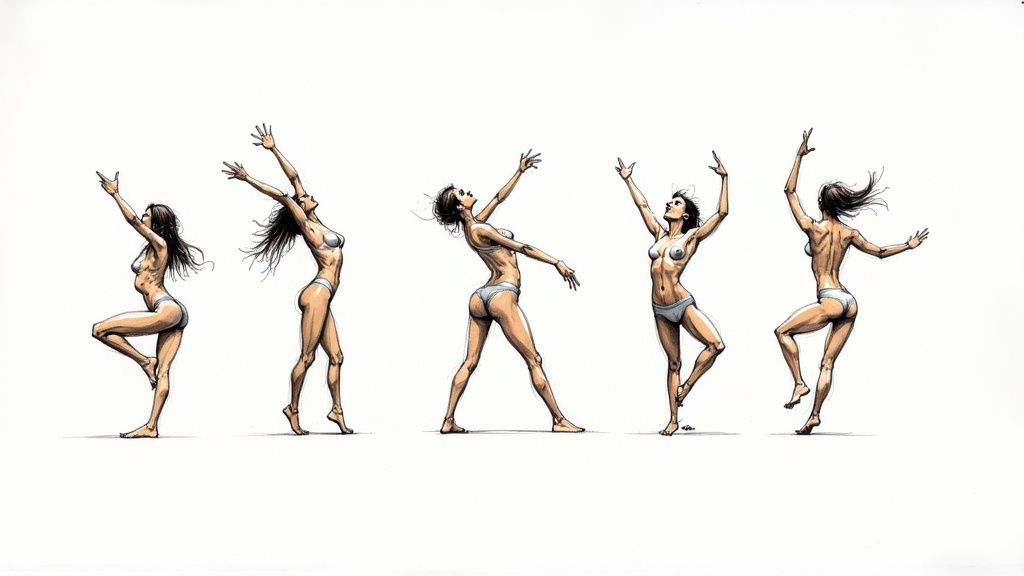
So many aspiring artists fall into the trap of just doodling more, hoping that's the secret sauce. While putting pencil to paper consistently is a big part of the equation, the quality of that practice matters most. This guide is designed to help you shift your focus from mindless repetition to purposeful exercises that build real, foundational ability.
We're going to dive into how seasoned artists actually hone their skills. It's not magic. It’s a mix of focused drills, sharp observation, and building sustainable habits that keep you growing. This is about adopting a professional mindset and using proven methods to get you where you want to be.
The Three Pillars of Drawing Improvement
To really see a change in your work, you need a solid framework. Here's a simple way to think about it. Every effective drawing exercise I've ever come across targets one of three core areas. Understanding these "pillars" gives you a clear roadmap for what to work on next.
Here’s a quick breakdown of what these pillars are and why they are absolutely essential for your growth.
Pillar | What It Means for You | Why It's Non-Negotiable |
|---|---|---|
Observation | Truly seeing your subject—its shapes, values, and textures—instead of just drawing what your brain thinks is there. | This is the foundation of realism. Without it, your drawings will always feel flat and disconnected from reality. |
Technique | The physical skill of making marks. This includes everything from line control and shading to knowing your tools, be it a pencil or a stylus. | Good ideas are worthless without the mechanical skill to execute them. This is how you translate what you see into a drawing. |
Knowledge | The "rules" and theories of art, like perspective, anatomy, composition, and color theory. | This is the intellectual framework that helps you build believable worlds and create compelling images from imagination. |
As you can see, each pillar supports the others. Focusing your practice on these three areas will help you move beyond just copying what’s in front of you.
You'll start to understand why things look the way they do, which is the real key to unlocking your ability to draw from imagination.
In this guide, we’ll break down practical, actionable strategies for each pillar. We'll start with foundational techniques and work our way up to building a practice that fuels consistent, long-term growth and delivers results you can actually see in your art.
Building Your Skills with Drawing Fundamentals

If there's one thing that separates amateurs from artists who consistently improve, it's a deep respect for the fundamentals. I'm not just talking about knowing the definitions of line, shape, and form. I mean getting your hands dirty and truly internalizing these concepts until they become second nature. Real progress begins when these ideas travel from your brain down to your drawing hand.
Think of it like a musician running through scales. It's not the most exciting part of the process, but it's the bedrock for everything else. These exercises are the non-negotiable work that trains your eyes to see more accurately and your hands to create the marks you actually want to make.
So, let's put the abstract theory aside and get into some practical, repeatable exercises that will build both your confidence and your ability.
Train Your Hand with Line Exercises
Your control over the line is everything. Seriously. Before you can even think about shading a complex portrait, you need to be able to draw a straight line, a smooth curve, and a decent circle on command. This is all about building muscle memory.
A classic rookie mistake, for instance, is drawing from the wrist. This leads to those short, scratchy, uncertain lines we all made when we started. The pros draw from the shoulder and the elbow, which is the secret to creating long, confident, and fluid strokes.
Try these warm-ups every time you sit down to draw. Just grab a blank sheet of paper:
- Straight Lines: Fill the entire page with parallel lines. Do them horizontally, vertically, and then diagonally. The key is to do it without a ruler, focusing on a single, smooth motion for each line.
- Circles and Ovals: On another page, fill it with circles and ovals of all different sizes. Don't stress about perfection. The goal is consistent control. Let them overlap, and just try to keep the shapes clean and continuous.
And this isn't just for beginners. I know professional artists who have been drawing for decades, and they still start their day with these exact drills. It’s how you keep your hand sharp.
The core of learning to draw is training your observation skills. You learn to simplify complex objects into basic forms and start seeing values and light instead of just hard outlines.
Understand Form Through Contour and Gesture
Once your line control feels a bit more reliable, you can start using it to describe actual objects. Two of the most powerful exercises for this are contour and gesture drawing. They teach you to see in two completely different but equally important ways—one is slow and analytical, the other is fast and full of energy.
Contour drawing is all about training your eye to carefully trace the edges of an object. For a real challenge, try a blind contour: you look only at your subject and never at your paper, drawing the outline in one unbroken line. The final drawing will probably look wonky and distorted, but that’s not the point. The exercise forces your hand to move in sync with your eye, forging a powerful connection between what you see and what you draw.
Gesture drawing is the polar opposite. Here, the goal is to capture the essence and movement of a subject in a matter of seconds. Using quick, loose, expressive lines, you're trying to convey the action or core of a pose, not the little details. It’s an amazing way to learn how to bring life and dynamism into your work. If you're looking for subjects, you can find tons of drawing ideas for beginners that are perfect for practicing on.
By practicing both—the slow, deliberate observation of contour and the fast, intuitive marks of gesture—you build a much more versatile skill set. You learn to understand both the static form of an object and the living energy within it.
Practice with Purpose and Self-Critique
It's a common trap: drawing for hours on end, only to find you're making the same mistakes over and over. If you want to know how to improve your drawing skills quickly, the secret isn't just about putting in the time—it's about practicing with a clear objective. This is what we call deliberate practice.
Mindless sketching might feel productive, but it can create a false sense of progress. True growth happens when you shift your focus from quantity to quality, actively problem-solving and pinpointing the weak spots in your work. That's how you really accelerate your skills.
How to Spot Your Flaws and Plan Your Practice
I've found the best way to improve is to become my own toughest critic, but in a constructive way. It starts with looking at my work and honestly identifying what's not working—maybe the composition feels off, the proportions are wonky, or the anatomy is just plain wrong.
Once you spot a flaw, the next step is to find an exercise that directly targets it. This is how you break bad habits instead of just reinforcing them.
Here's a simple process I follow:
- I'll notice recurring mistakes, like my shading looking flat or my figures lacking gesture.
- Then, I match that mistake with a specific drill. For flat shading, I'll do value scale exercises. For stiff figures, it's all about quick gesture studies.
- To keep things fresh and well-rounded, I typically rotate through three focused drills per week.
- I track my progress by re-drawing a simple subject each week and comparing the new version to the old one. The improvement is often surprising.
Don't just take my word for it. A 2022 study published in Frontiers in Psychology confirmed that simply drawing more doesn’t make you better at composition. The researchers found that artists who actively engaged in self-correction performed significantly better than those who just churned out a high volume of work.
This infographic breaks down a focused workflow for shading that you can start using right away.
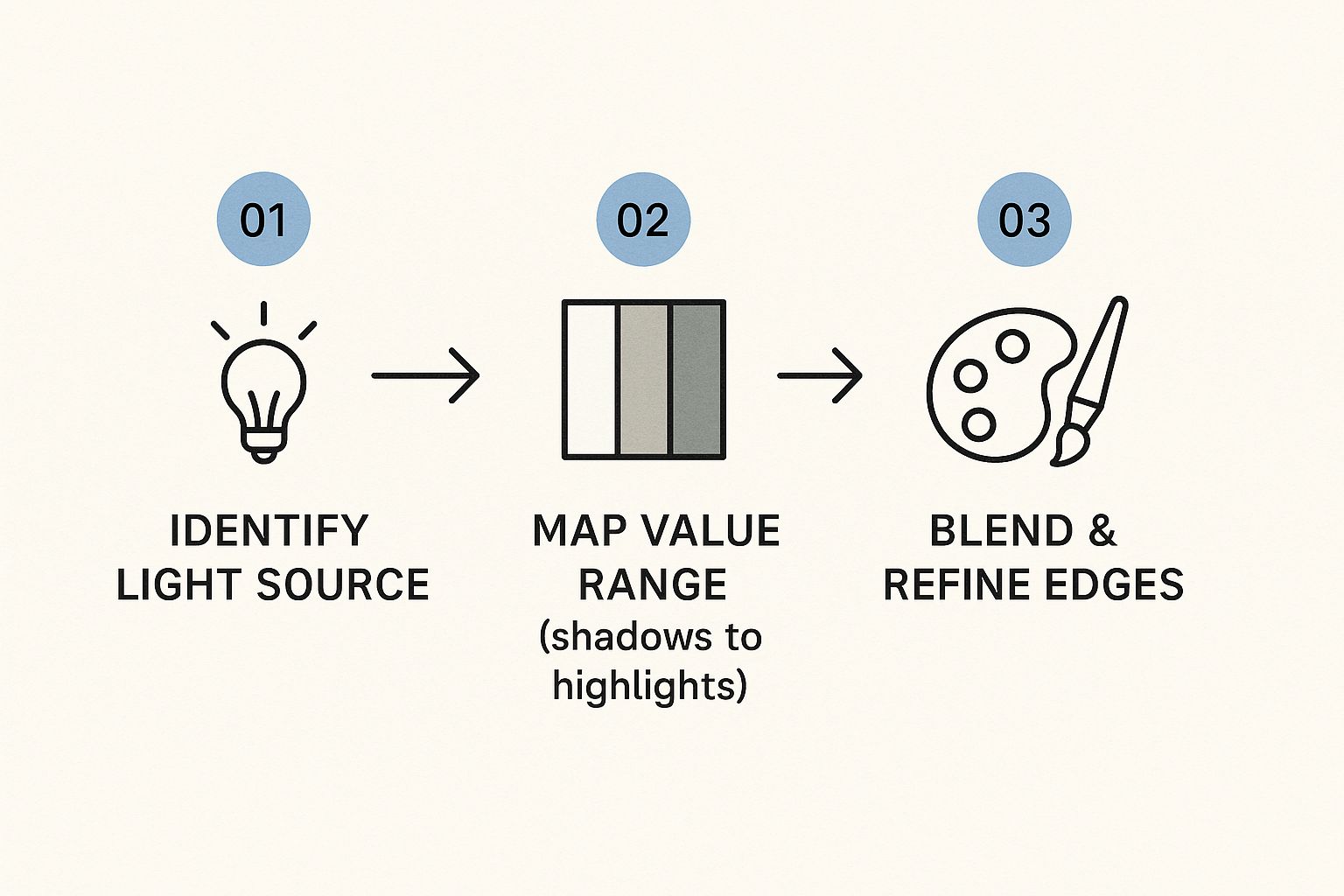
As you can see, the process moves from identifying the light source all the way to refining the edges. Each step is designed to tackle a core challenge in creating believable shading.
Make Daily Reflection a Habit
At the end of every drawing session, take just a few minutes for a quick self-critique. It's a powerful way to make sure the lessons stick.
Ask yourself a few simple questions:
- What part of this drawing worked out well, and why?
- Which shapes or lines feel the most inaccurate or awkward?
- Did my use of light and shadow create a real sense of depth?
If you're looking for new subjects to practice on, our guide on step-by-step drawing ideas has plenty of prompts that pair perfectly with these drills.
Focused reflection transforms every sketch into a lesson rather than a mere doodle.
I find it incredibly helpful to jot down short notes right in my sketchbook, next to each drawing. This creates a personal log of my insights and keeps me honest. Over a few weeks, you'll start to see patterns emerge, which makes it so much easier to decide what to practice next.
Set Up Monthly Checkpoints
To see your progress on a larger scale, try setting monthly checkpoints. Pick one specific area to focus on for the entire month—let's say it's hands, a classic challenge for many artists.
Your goal could be to complete five dedicated hand sketches over the month. When you're done, compare your first attempt with your last one. You'll be able to see tangible improvement.
A simple log can help you track your journey.
Date | Focus Area | Insight |
|---|---|---|
Week 1 | Hands | My value transitions are a bit harsh and need smoothing out. |
Week 4 | Hands | I have much better control over the tones, and the forms look more solid. |
This kind of focused approach makes every minute you spend drawing count. Trust me, one hour of mindful, deliberate work will do more for your skills than five hours of doodling without a plan. Stick with it, and you’ll see a real difference in your art.
Turn Your Drawings Into a Powerful Learning Tool
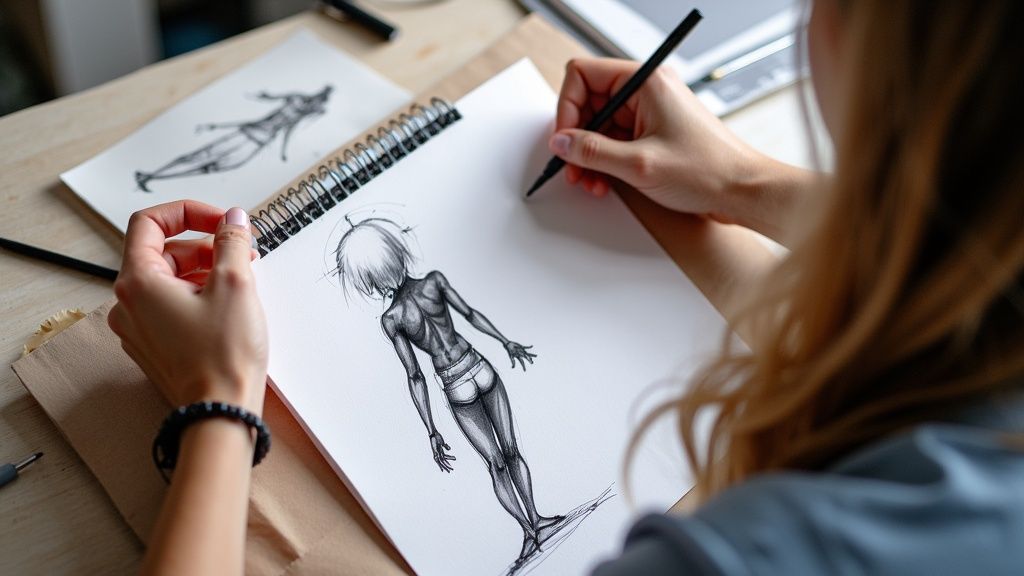
What if your sketchbook wasn't just for making art? What if it was one of the most powerful learning tools you could possibly own? When you draw something, you’re doing far more than just passively observing it—you’re forced to engage with it on a much deeper level.
The act of putting pencil to paper makes your brain work differently. You have to break a subject down into its basic shapes, understand its structure, and see how all the different parts fit together. This isn't just copying; it's a full-on analysis. And because you’re actively processing the information, it sticks in your memory far better than if you had just read about it.
This simple shift in perspective can completely change how you view your practice. Your sketchbook is no longer a gallery for your best work; it's a laboratory for observation, a place where every line you draw builds a stronger understanding.
Your Sketchbook as a Learning Lab
Ready to give it a try? Pick something you genuinely want to understand, and instead of just taking notes on it, draw it. This simple exercise can make even the most complex information feel tangible and, more importantly, memorable.
Here are a few ways I've used this in my own work:
- Learning Anatomy: Don't just stare at diagrams of a hand. Actually draw the bones—the carpals, metacarpals, and phalanges—from a few different angles. Once you have that down, try drawing the muscle groups on top. You’ll find you understand the structure in a way that reading about it just can't match.
- Mastering Perspective: Theory is one thing, but practice is everything. Go outside and sketch a street corner or a building. Actively looking for the vanishing points and drawing the convergence lines will make those abstract rules suddenly click into place.
- Understanding Mechanics: Ever wondered how a bicycle's gears actually work? Sit down and sketch the whole system. Trace the path of the chain and see how it moves between sprockets. Drawing it forces you to solve the visual puzzle, making the mechanics feel intuitive.
Your sketchbook can become your best study guide. The goal isn't to create a perfect, polished piece of art. It’s to make the information yours. Often, the messiest, most analytical drawings are the ones that teach you the most.
The Science Behind It All
This isn't just a neat trick; it's a method backed by some fascinating cognitive science. Researchers have studied what they call the "drawing effect," and the results show just how much this active engagement can boost memory.
One study found that students who drew information were able to recall it nearly twice as well as students who simply wrote down definitions. What's incredible is that this boost in memory had nothing to do with artistic skill. It proves that drawing is a powerful learning strategy for anyone. You can dive deeper into the research by reading the full study on drawing and memory.
So, every time you sit down to practice, remember that you’re not just improving your drawing skills. You're also sharpening your ability to observe, analyze, and remember. Embracing this mindset makes the whole journey feel that much more rewarding.
Expanding Your Skills Beyond the Sketchbook
If you really want to level up your drawing, you have to look beyond the pages of your sketchbook. Think about it: truly exceptional artists rarely develop their skills in a vacuum. A well-rounded artistic education, even one you build for yourself, feeds directly back into the quality of your lines, the strength of your compositions, and the depth of your ideas.
Drawing isn't just about mastering a technique; it's a form of visual communication. By digging into related fields, you start building a huge mental library of solutions to visual problems. Becoming a great artist is about so much more than just having a skilled hand. It's about having a well-trained eye and an informed mind.
Become a Student of Visual Language
Studying other visual disciplines gives you an enormous advantage. Understanding color theory from painting, for instance, will dramatically improve your value choices, even when you're only working with a graphite pencil. Learning about composition from photography will instantly make your own layouts more dynamic and intentional.
This cross-pollination of skills is where the real growth happens. Here are a few areas I always recommend exploring:
- Art History: Forget about just memorizing dates. This is about deconstructing how masters like Rembrandt used light to create mood or how Michelangelo practically sculpted form with a single line.
- Photography: Get familiar with the rule of thirds, leading lines, and framing. Analyzing great photos is a fantastic shortcut to understanding what makes a powerful composition.
- Sculpture: Seeing how a sculptor creates a three-dimensional form will deepen your own understanding of weight, balance, and how objects actually occupy space.
When you start looking at these fields, you begin to see the universal principles that make any piece of art successful. The goal is to become a complete visual artist, not just a technician who can render well.
You start to build an intuition for what works and, more importantly, why it works. This knowledge is what separates an artist who simply copies from one who truly creates.
Actively Analyze the Art Around You
You don't need to enroll in a formal class to get started. Your education can begin right now, whether you're standing in a museum or just scrolling through art online. The key is to analyze, not just consume.
When you look at a piece, ask specific questions. How did the artist guide my eye through the image? What conscious choices did they make with light and shadow? Why this color and not another?
This kind of active analysis is an incredibly powerful exercise. And if you find yourself stuck and need a little spark to get going, our list of easy drawing ideas is perfect for getting that creative energy flowing again.
This broader approach to art education has benefits that go far beyond your sketchbook. In fact, research confirms that arts education has a significant impact on our overall cognitive abilities. People with consistent access to art develop stronger critical thinking, sharper observational skills, and more creative problem-solving—all of which are invaluable in any part of life. You can dive deeper into these powerful findings and learn more about the impact of arts education.
A Few Common Questions I Hear from Artists
As you start getting serious about drawing, you're bound to run into questions and hit a few walls. It's just part of the process. Every artist I've ever known, myself included, has faced these same hurdles. Let's tackle some of the most common ones with practical advice that builds on what we've already covered.
How Long Does It Take to Get Good at Drawing?
This is the big one, isn't it? The honest-to-goodness answer is: it really depends. The idea of "good" is always changing, both for you and for others. A much better question to ask yourself is, "How can I see steady progress?" The secret isn't locking yourself away for eight hours every Saturday. It's about building a habit you can actually stick with.
You'll see far more significant gains with just 20-30 minutes of focused, deliberate practice every single day than you will from one marathon session a week. Think of it like training a muscle—it’s about consistency, not intensity. This is a long game, so trust that all those small, daily efforts are compounding into something real.
What Are the Essential Tools to Start Drawing?
So many aspiring artists think that a pile of expensive gear is the key to making better art. The truth is, you don't need a fancy setup to nail the fundamentals. In fact, starting simple is usually the better route because it forces you to rely on your skills, not your tools.
To get started, you really only need a few basics:
- A simple graphite pencil: A standard HB or 2B pencil is a workhorse. It’s perfect for everything from your first line exercises to more complex value studies.
- A good eraser: I'd suggest a kneaded eraser. They don't tear your paper, and you can mold them into different shapes for precise, detailed erasing.
- Any plain paper: Seriously. A basic sketchbook or even a stack of copy paper is more than enough to practice on.
Let’s be clear: the idea that better tools create a better artist is a total myth. Your skill lives in your hand, your eye, and your mind—not in your wallet. Master the basics with simple tools, and you’ll find you can create compelling art with just about anything.
What Should I Do When I Feel Stuck or Plateaued?
Hitting a plateau doesn't mean you're failing; it means you're ready for the next stage of growth. Every single artist I know has periods where they feel completely stuck or uninspired. Instead of getting frustrated and trying to force your way through it, take it as a signal to mix things up.
When you feel that wall go up, put your main project aside and try something completely different. If you normally draw with a pencil, grab a pen and ink or some charcoal. If you always draw people, try drawing buildings or animals.
Sometimes, the best thing to do is go right back to the beginning. Spend a whole session just doing simple line exercises or some blind contour drawings. Another trick I love is to start a "bad drawing" sketchbook—a dedicated place where you draw just for the fun of it, with absolutely zero pressure for it to look good. This simple mental shift can be surprisingly effective at breaking the block and getting your creative energy moving again.
Should I Start with Digital or Traditional Drawing?
This debate comes up all the time, but honestly, it’s not the most important question. The fundamentals of drawing—understanding form, value, perspective, and composition—are universal. Those core principles are exactly the same whether you’re holding a pencil or a stylus.
Many artists, myself included, find that starting with traditional tools like graphite helps build a stronger feel for line weight and pressure. There’s a direct, physical feedback from paper that you just can't quite replicate on a screen. That said, your choice should really come down to what you want to do long-term. If your dream is to be a concept artist for video games, then it makes sense to get comfortable with a digital workflow sooner rather than later.
Ultimately, the tool is secondary to the skill. Don't let the choice paralyze you. Just pick one, focus on building a solid foundation, and trust that those skills will transfer to any medium you decide to explore down the road.
Feeling inspired to tackle a new challenge? At Drawing List, we’ve created a powerful tool to help you blast through artist's block and keep your sketchbook full. Our AI-powered generator provides thousands of unique prompts to spark your creativity. Find your next great idea.
